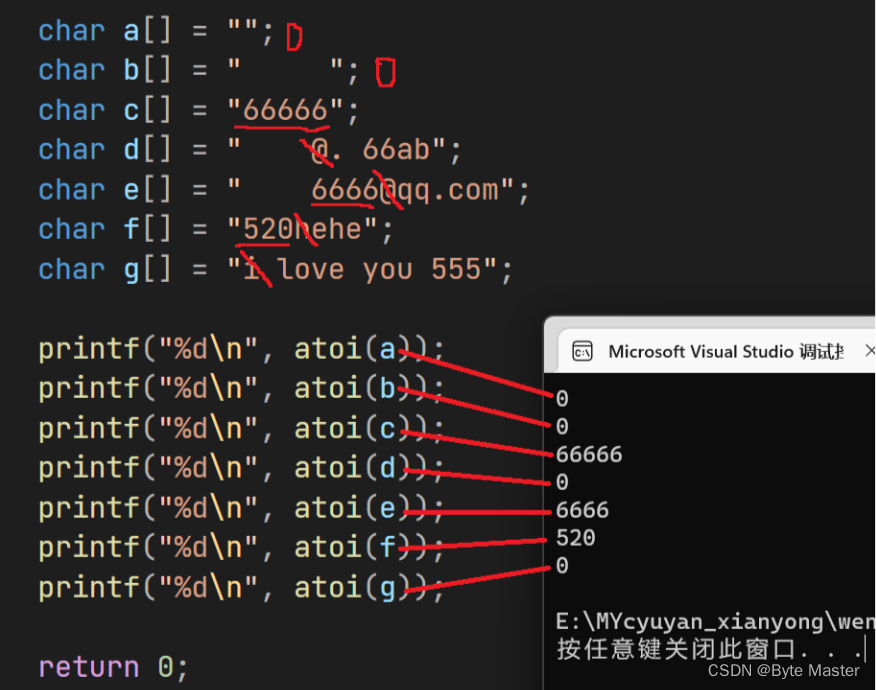C语言——atoi函数解析
发布时间:2024年01月18日
目录
前言
- 对于
atoi函数大家可能会有些陌生,不过当你选择并阅读到这里时,请往下阅读,我相信你能对atoi函数熟悉- 该函数的头文件为
<stdlib.h>?或?<cstdlib>
atoi函数的介绍
此函数的功能是将数字字符的字符串转化为字面上的整型返回,例如:
char arr[] = "1234";
将”1234“ -> 1234(int)
以下是函数原型:
 ?
?
 ?
?
要注意的点:
- 如果字符串首元素不是空格字符
- 如果第一个字符不是数字字符,直接返回
0。 - 如果第一个字符是数字字符, 则从这个数字字符开始转换,并向后找连续的数字字符转换 ,如果连续中断,找到不是数字字符的字符,则在此截断寻找,返回前面已经转换好的连续的数字字符字面整型值。
- 如果第一个字符不是数字字符,直接返回

- 如果字符串首元素不是空格字符
- 如果第一个字符不是数字字符,直接返回
0。 - 如果第一个字符是数字字符, 则从这个数字字符开始转换,并向后找连续的数字字符转换 ,如果连续中断,找到不是数字字符的字符,则在此截断寻找,返回前面已经转换好的连续的数字字符字面整型值。
- 如果第一个字符不是数字字符,直接返回

- 如果字符串全部为空格字符,返回0;如果为空字符串,返回0;
atoi函数的使用
- 有了上面的介绍,使用的意图变得明显,使用起来也就随手就来了。
例如:
#include <stdio.h>
#include <stdlib.h>
int main()
{
char a[] = "";
char b[] = " ";
char c[] = "66666";
char d[] = " @. 66ab";
char e[] = " 6666@qq.com";
char f[] = "520hehe";
char g[] = "i love you 555";
printf("%d\n", atoi(a));
printf("%d\n", atoi(b));
printf("%d\n", atoi(c));
printf("%d\n", atoi(d));
printf("%d\n", atoi(e));
printf("%d\n", atoi(f));
printf("%d\n", atoi(g));
return 0;
}
 ?
?
看上的结果,是不是就与介绍当中的点都对应起来了呢?
atoi函数的模拟实现
有了上面的铺垫,我们已经了解了该函数的特性,所以接下来的实现也就变的简单了
- 跳过空格字符(也可能没有,就不跳直接开始判断转换);
- 跳过后开始判断转换;
- 无论何种方式开始判断第一个字符,如果不是数字字符,直接返回0。
#include <stdio.h>
#include <assert.h>
// 数字ASCLL码值范围为 48—57
int my_atoi(const char* str)
{
assert(str);
const char* tmp = str;
while (*tmp == ' ') // 跳过空格字符
tmp++;
int num = 0; // 转换数字字符值的接收变量
// 如果是数字字符,就进来,到不连续处就停止
while (*tmp <= 57 && *tmp >= 48)
{
num = num * 10 + (*tmp - '0');
if (*(tmp + 1) < 48 || *(tmp + 1) > 57)
{
return num;
}
tmp++;
}
// 如果开始判断的字符不是数字字符,前面的循环不进去,这里直接返回0
return 0;
}
int main()
{
char a[] = "";
char b[] = " ";
char c[] = "66666";
char d[] = " @. 66ab";
char e[] = " 6666@qq.com";
char f[] = "520hehe";
char g[] = "i love you 555";
printf("%d\n", my_atoi(a)); // 0
printf("%d\n", my_atoi(b)); // 0
printf("%d\n", my_atoi(c)); // 66666
printf("%d\n", my_atoi(d)); // 0
printf("%d\n", my_atoi(e)); // 6666
printf("%d\n", my_atoi(f)); // 520
printf("%d\n", my_atoi(g)); // 0
return 0;
}
文章来源:https://blog.csdn.net/Evan26/article/details/135682897
本文来自互联网用户投稿,该文观点仅代表作者本人,不代表本站立场。本站仅提供信息存储空间服务,不拥有所有权,不承担相关法律责任。 如若内容造成侵权/违法违规/事实不符,请联系我的编程经验分享网邮箱:chenni525@qq.com进行投诉反馈,一经查实,立即删除!
本文来自互联网用户投稿,该文观点仅代表作者本人,不代表本站立场。本站仅提供信息存储空间服务,不拥有所有权,不承担相关法律责任。 如若内容造成侵权/违法违规/事实不符,请联系我的编程经验分享网邮箱:chenni525@qq.com进行投诉反馈,一经查实,立即删除!
最新文章
- Python教程
- 深入理解 MySQL 中的 HAVING 关键字和聚合函数
- Qt之QChar编码(1)
- MyBatis入门基础篇
- 用Python脚本实现FFmpeg批量转换
- python图片批量下载多线程+超时重试
- 微信小程序格创校园跑腿小程序源码v1.1.64+前端
- 提升工作效率:IDEA配置优化总结指南
- Sumerra验厂审核清单
- C#编程-使用变量
- 数据结构(二)基本概念和术语
- leetcode算法题之记忆化搜索总结
- OpenXP(Windows Server 2003 RTM,NT 5.2.3790.0)构建指南
- 2024年美赛数学建模思路 - 复盘:光照强度计算的优化模型
- 暴打小苹果